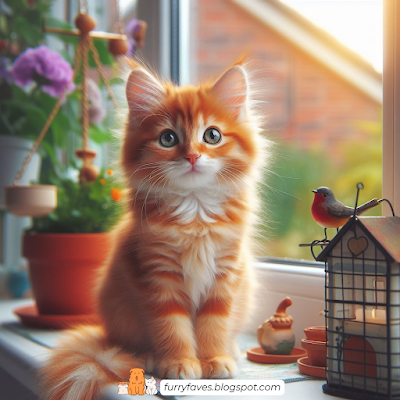Incredible Facts About Orange Cats You Didn’t Know
As a devoted cat enthusiast and content creator, I’ve had the pleasure of diving into the delightful world of feline facts. Today, let’s unravel the enigma of orange cats—those vibrant, sun-kissed felines that grace our lives with their warm hues and quirky personalities. Buckle up, fellow cat lovers, because we’re about to explore some incredible tidbits that will leave you in awe of these fiery furballs.
This post may contain affiliate links at no extra cost to you. Please read our full disclosure here to find out more.
All Orange Cats Are Tabbies
When you think of orange cats, you might picture Garfield or that neighbor’s friendly ginger kitty. But did you know that all orange cats fall under the tabby category? The term “tabby” refers to coat markings rather than a specific breed. It’s like a secret club where every orange cat gets an automatic membership card. The word “tabby” itself has an intriguing origin—it hails from the striped silk fabrics made in Iraq. So, whether your orange cat sports bold stripes or subtle swirls, they’re all part of the tabby tapestry.
The “M” Marking: A Cosmic Signature
Observe closely, my fellow cat aficionados. On the forehead of every orange cat lies a mysterious symbol—an unmistakable “M” shape etched in their fur. Some say it stands for “magnificent,” while others believe it’s a cosmic signature. The truth? It’s all about genetics. The “M” is like their feline fingerprint, a result of their DNA. So next time you gaze into your orange cat’s eyes, remember that they carry this ancient emblem passed down through generations.
Gender Bias: Orange Cats Are Mostly Male
Prepare to be amazed by the sex-linked gene responsible for orange fur. Approximately 80% of orange tabby cats are male. Why? Blame it on the X chromosome. You see, the gene for orange fur resides on the X chromosome. Female cats have two X chromosomes, while males have one X and one Y. If a male inherits the orange gene, voilà! He’s rocking that fiery coat. But for a female to flaunt orange fur, she needs two copies of the gene—one from each parent. It’s like a genetic game of chance, and the boys seem to have luck on their side.
Chatty Cathy’s: Orange Cats Love to Talk
Picture this: You’re sipping your morning coffee, and your orange cat hops onto the kitchen counter. Suddenly, a symphony of meows ensues. Why? Because orange cats are the opera singers of the feline world. They love to chat, narrate their adventures, and discuss existential matters (probably). Gary Weitzman, head veterinarian at the San Diego Humane Society, confirms it. So, if your orange cat serenades you at 3 a.m., consider it a privilege—you’re part of their exclusive audience.
Trademark Black Freckles: A Cosmic Constellation
Look closely at your orange cat’s nose and ears. Notice those tiny, black freckles? They’re like celestial constellations sprinkled across their sunny canvas. These freckles result from a genetic condition called lentigo. It’s common in calico and tortoiseshell cats too. While they add character, keep an eye on any changes. If those freckles start tap-dancing or throwing parties, consult your veterinarian. Cosmic freckles are charming, but we want them to stay healthy.
Pheomelanin: The Red-Haired Connection
Remember redheads? Well, orange cats share a kinship with them. Their vibrant hue comes from a pigment called pheomelanin. It’s like the cat version of coppery locks. So, the next time you admire your orange cat’s coat, imagine them strutting down a catwalk with a fiery mane, turning heads and causing feline envy.
Velcro Cat Reputation: Sticky Love
While scientific studies are scarce, cat enthusiasts often describe orange cats as velcro kitties. They’re the ones who glue themselves to your lap, your keyboard, and your heart. Whether it’s their predominantly male population or their inherent friendliness, orange cats seem to crave human connection. So, embrace the sticky love—they’re like warm, purring Post-it notes.
Types of Stripes: Agouti Magic
Let’s talk patterns. The agouti gene is the wizard behind the curtain, creating coat magic. Orange cats can flaunt four tabby patterns:
The Mythical Solid Orange Cat
Now, brace yourself for a revelation: solid orange cats don’t exist. Yes, you read that right. While their coats may appear solid, they’re actually subtle tabbies. The agouti gene weaves its magic even in seemingly monochromatic fur. So, when you stroke your orange cat, remember that beneath that sunny exterior lies a hidden tapestry of patterns.
A Toast to Orange Whiskers
As we wrap up our journey through the orange cat cosmos, let’s raise our imaginary catnip tea cups. These fiery felines bring warmth, laughter, and a touch of cosmic wonder to our lives. Whether they’re napping in sunbeams or plotting world domination (one yarn ball at a time), orange cats deserve our admiration.
And hey, if you’re looking for a cozy read to accompany your cat cuddles, here are some recommended books:
And for a touch of whimsy, consider an orange cat-shaped mug or a cat-themed puzzle from Amazon. Because life is better with a dash of feline magic.
Here's an article which might interest you
From Scruffy to Stunning: Transform Your Cat's Appearance with These Tips
Cat Trees for Small Spaces: How They Can Improve Your Cat’s Behavior
How to Keep Your Senior Cat Happy and Healthy: 10 Expert Tips




Comments
Post a Comment